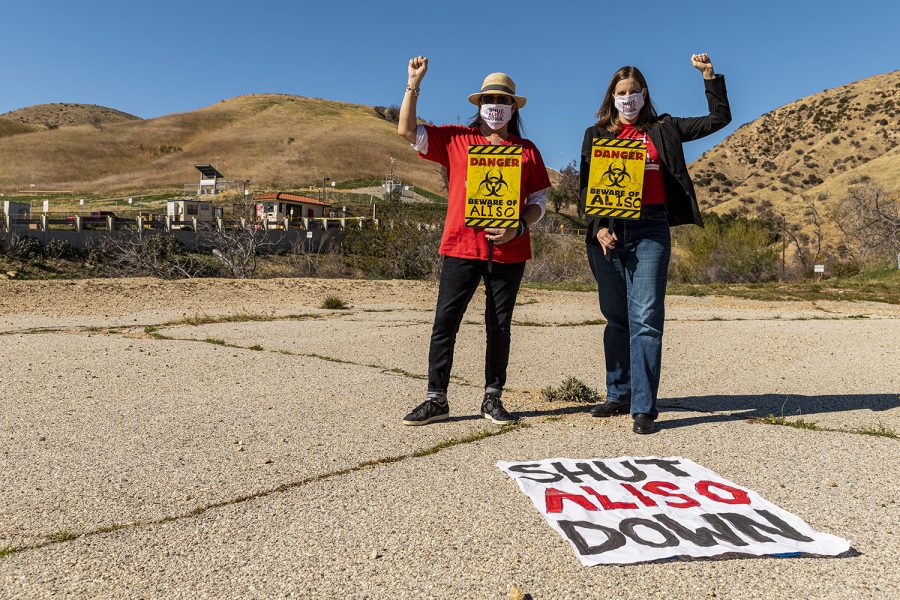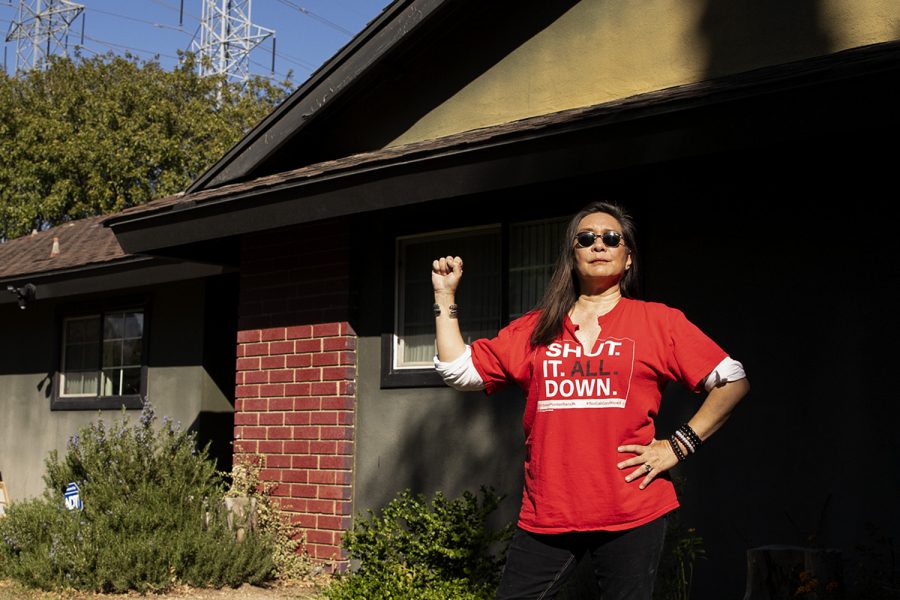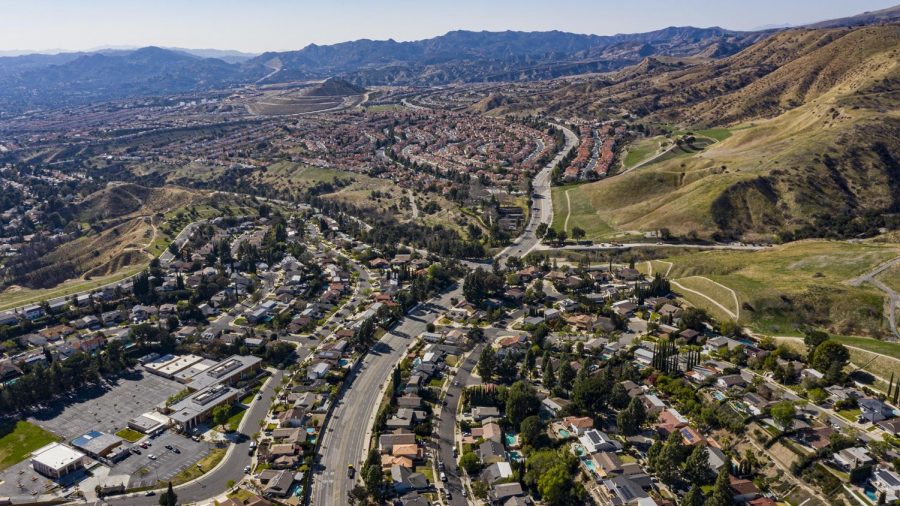Porter Ranch residents suffer negative health effects following Aliso Canyon gas leak
March 3, 2021
**Editors Note: Article has recently been updated with new information**
After sneaking backstage while attending the 2019 California Democratic Convention in San Francisco, Porter Ranch resident and Aliso Canyon protester Jane Fowler was able to approach Gov. Gavin Newsom about shutting down the Aliso Canyon gas storage facility.
“We have got to get that thing shut down,” said Newsom in a video recorded by the Food and Water Watch. “I’m working on it.”
Newsom also mentioned in the video that shutting down the gas facility was “at the top of our agenda.”
Contrary to his statements, the Aliso Canyon gas storage facility has not been shut down. Gas withdrawals from the facility are up by 4755% since Newsom was elected, according to data collected from the California Public Utilities Commission by the Food and Water Watch.
Aliso Canyon was the site of the nation’s largest-ever uncontrolled natural gas leak in 2015 and Porter Ranch residents are still experiencing health issues six years after the blowout.
“I feel like my life has been taken from me,” Fowler said. “When you’re not feeling well everyday or five days a week or two days a week and you don’t know which day it’s going to be, it affects your life.”
Fowler said she knows she has to move out, but at 61 years old, starting a new life somewhere else may be difficult.
“I know at 61 you can do anything, but I’m also a 61-year-old that has been physically, mentally, emotionally, psychologically and neurologically harmed,” Fowler said.
On Oct. 23, 2015, gas spewed out of the Aliso Canyon natural gas storage facility and released nearly 100,000 tonnes of natural gas into the air along with toxic chemicals, forcing thousands of San Fernando Valley residents out of their homes before the leak was capped four months later.
Fowler, along with many other Porter Ranch residents, reported having headaches, bloody noses, nausea and rashes. Residents also claimed to experience a “brain fog,” a term used for certain symptoms that can affect your ability to think clearly. According to San Francisco Neuropsychology, people suffering from brain fog may experience problems with attention, concentration, speech, memory, organization and other cognitive skills.
“I couldn’t even make a grocery list,” said Lori Aivazian, a Porter Ranch resident and founding member of the Aliso Moms Alliance, a group of mothers who aim to bring accountability and transparency in any areas affecting their family’s well being. “I’d wake up in the morning and sit up in bed and have to think about how to put each foot down on the floor.”
In Sept. 2021, Southern California Gas Company and its parent company, Sempra Energy, agreed to pay $1.8 billion to settle claims from more than 35,000 plaintiffs affected by the gas leak. A settlement has not yet been reached because it requires 97% of the plaintiffs to accept it in order for it to be finalized.
Matt Pakucko, the president of the nonprofit organization Save Porter Ranch, said each of the plaintiffs would receive around $28,000 after attorney fees and expenses.
“Does $28,000 cover [the medical expenses] for the rest of our lives being health monitored because of the ongoing issues?” Pakucko asked. “It doesn’t even come close.”
The “Root Cause” analysis that was released in 2019 by Blade Energy Partners, the company hired by SoCalGas to investigate the site of the leak, determined that the cause of the blowout was a corroded pipe that was in contact with groundwater.
The analysis also said there were more than 60 casing leaks at Aliso Canyon before the October 2015 incident, going back to the 1970s, but no failure investigations were conducted by SoCalGas.
Patricia Oliver, an attorney with Parris Law Firm who represents the Porter Ranch residents who were affected by the gas leak, said the Blade report stated in order to kill the well, they had to drill a relief well. This operation did not start until Dec. 4, 2015.
Oliver also mentioned that by drilling the relief well in December, the peak level of gas has already leveled off. This means SoCalGas decided to plug the leak nearly two months after the leaking gas was at its peak.
“How much time is going on while you’re contributing to climate change, creating a public health nightmare, forcing relocations of schools and homes, yet plan B doesn’t start until Dec. 4,” said Oliver.
In 2016, then-Gov. Jerry Brown declared the situation an emergency. During Brown’s last two years in office, Aliso Canyon saw minimal usage.
However, when Newsom was elected in 2018, SoCalGas lobbied and succeeded in justifying “looser regulations,” according to Alexandra Nagy, California director for the national grassroots advocate organization Food & Water Watch and Food and Water Action.
“Compared to Brown, in Newsom’s first two years, that’s a 3,000% difference [in gas withdrawals],” Nagy said in an article for the San Fernando Sun.
In 2019, Newsom said he wanted to “fast track” the expedited shutdown of Aliso Canyon and possibly close the facility faster than the 10-year timeline proposed by Brown in 2017.
Yet, the facility has not been shut down.
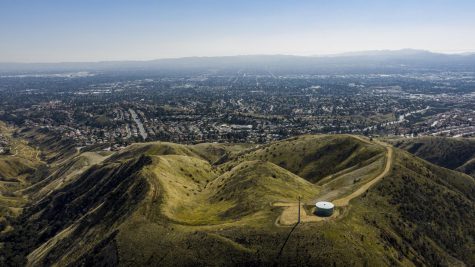
Data shows that SoCalGas withdrew from Aliso Canyon for 60 days during the winter 2020-2021 season, and 54 days over the winter 2019-2020 season — a combined total of 38 billion cubic feet. This compares to eight days of withdrawals for winter seasons 2016-2017 and 2017-2018 with a combined 1.19 billion cubic feet, according to research from the Food and Water Watch.
Nagy said that the increased usage of Aliso Canyon is a direct result of the California Public Utilities Commission weakening the withdrawal protocols and regulations that removed the “last resort” and “emergency” restrictions to use the facility. This essentially gives SoCalGas unrestricted access to withdraw from the facility as the company sees fit.
As a result, the data Nagy collected shows that in addition to a large increase in gas withdrawn from Aliso Canyon, the facility is often used as “an asset of first resort, supplying more than half of the total gas withdrawn regionally on any given day.”
The CPUC relaxed restrictions placed on the facility because of concerns of high energy prices and supply shortages, the Los Angeles Times reported.
Terrie Prosper, director of the CPUC’s news and outreach office, said in an email that Aliso Canyon may only be used for withdrawals if certain conditions are met. These conditions include withdrawing from the facility if it is above 70% of its maximum allowable inventory, and if an emergency that would impact public health could be mitigated by withdrawals from Aliso Canyon.
The CPUC’s Aliso Canyon Withdrawal Protocol also says “withdrawals shall be made in a manner that ensures safety, maintains the integrity of the wells and storage facility, and is consistent with all rules and regulations concerning the safe use of Aliso Canyon.”
In addition to more gas withdrawals, the CPUC issued a proposal and an alternate proposals to increase the amount of natural gas stored in Aliso Canyon. The current gas storage limit at the facility is 34 billion cubic feet. The initial proposal would increase the amount to 68.6 cubic feet, according to a press release from the CPUC.
Commissioner Martha Guzman Aceves’ alternate proposal would increase the storage capacity to 41 billion cubic feet. Both proposals will be considered at the CPUC’s voting meeting on Nov. 4, 2021.
“It’s just a huge slap in the face to this whole process and effort of getting the facility shut down,” Nagy said. “We’ve seen what it looks like to operate this facility at a minimal use and not only have they allowed withdrawals to expand, but they’re going to increase the size of the field too.”
The leak itself emitted about 100,000 metric tons of methane into the Porter Ranch area, state regulators said.
The SoCalGas website says methane is “non-toxic and creates no hazard when inhaled in limited quantities.” However, Oliver noted that methane is listed on the U.S. inventory as being a toxic chemical.
SoCalGas also said if large quantities of methane are present to displace air, “lack of oxygen may result in suffocation.” In response to this statement, Oliver said SoCalGas failed to differentiate the exact amount at which the exposure results in getting headaches and which amount can result in death.
“Where do you get to the point that you die versus just having a headache or dizzy?” Oliver said. “As far as I know, nobody at Southern California Gas knows. So if you tell me if you have a headache because methane is taking up part of the oxygen you should be breathing in, that’s pretty bad. That’s making you sick.”
SoCalGas did not respond to multiple requests for comment.
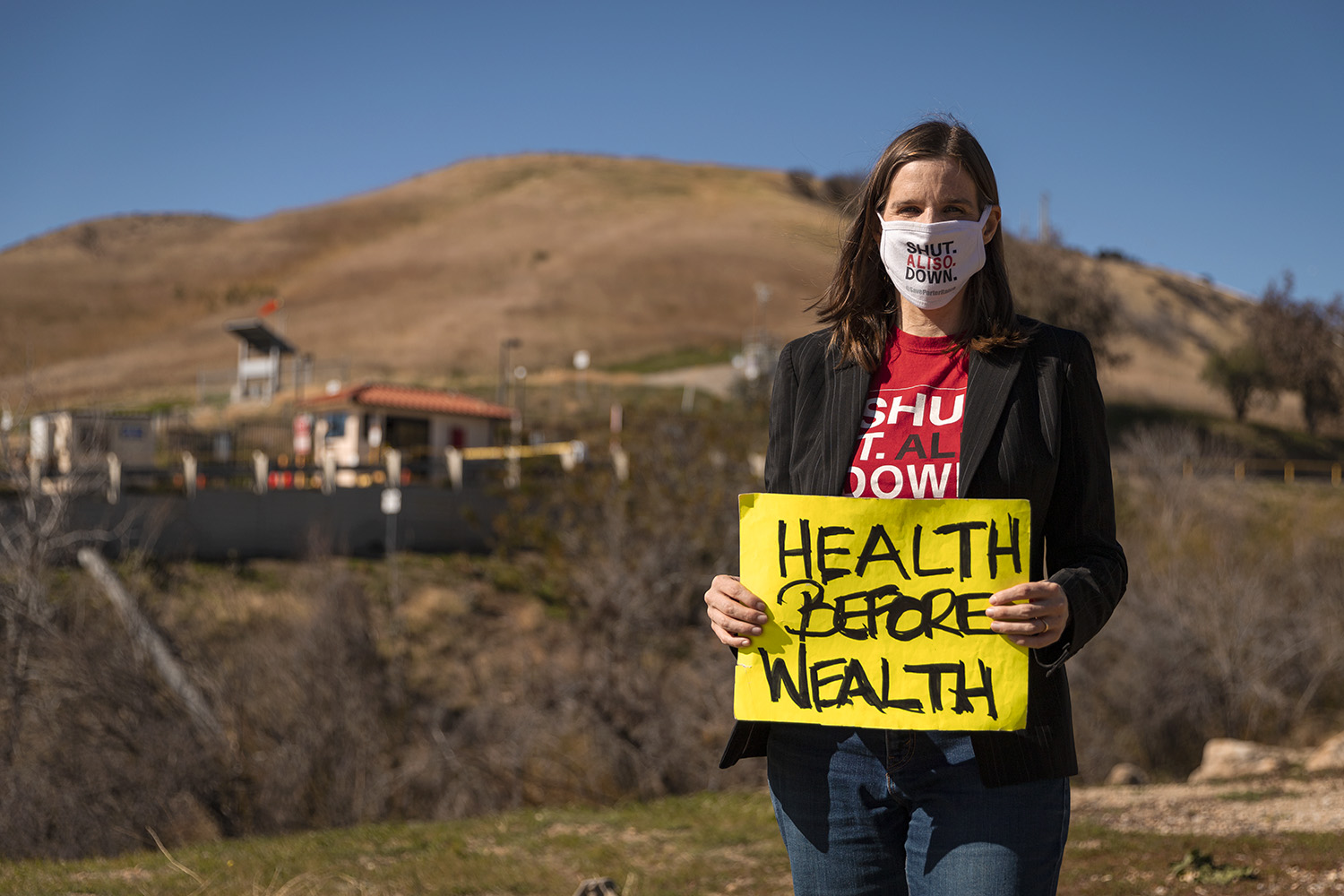
Despite methane being labeled as “non-toxic” for humans by SoCalGas, the gas has a negative, long-term impact on the environment, according to Loraine Lundquist, a physicist, climate activist and sustainability lecturer at CSUN.
Lundquist said that leaking natural gas is a factor in global warming because methane is a potent greenhouse gas that causes the Earth to warm.
“Climate change usually feels like something that’s far away and that doesn’t doesn’t impact me viscerally,” Lundquist said. “[The gas leak] seemed to me at the time that it could be a catalyst for recognizing the danger of these fossil fuels and of this fossil fuel infrastructure and calling attention to it.”
Lundquist ran for office to represent Los Angeles City Council District 12, which includes Porter Ranch and other areas of the San Fernando Valley, in 2020. She said that this particular incident massively affected her community where she resides.
She remembered students experiencing symptoms of nosebleeds, nausea and dizziness while in class during the time of the gas leak. The severity of this incident inspired her to become an advocate for the closure of the Aliso Canyon gas storage facility.
According to Lundquist, there was no immediate comprehensive study done on the health effects of methane after the blowout.
However, a $120 million settlement held SoCalGas responsible for the Aliso Canyon gas leak in February 2019 will fund a long-term health study and other environmental projects.
“SoCal Gas will pay civil penalties along with $25 million for the long-term health study and $26.5 million for greenhouse gas emissions projects, reimburse the city, county and state governments for costs associated with their response to the leak,” Los Angeles Daily News reported.
A study published in 2019 by Environmental International that included sustainability experts from University of California, Los Angeles and Berkeley confirmed that hazardous air pollutants known to cause cancer and other serious health impacts were emitted from the blowout. These gaseous and particle chemicals reached proximate communities and likely affected indoor living environments.
The Blade report also said that small amounts of the cancer-causing chemicals, such as benzene and other toxic pollutants, were included in the leak.
“There are other trace chemicals within natural gas itself, but this gas that is stored at Aliso Canyon is stored in a depleted oil field,” Lundquist said. “Oil has a lot of cancer-causing chemicals that have problematic health effects, such as benzene.”
Dr. Bruce Gillis, a medical doctor and the founder of EpicGenetics, a biomedical company involved in developing conclusive diagnostic tests for complex medical conditions, was hired by Oliver to conduct research and assess five individuals living in Porter Ranch who were exposed to benzene.
Gilis said they collected blood samples from the five residents who varied in gender, age, ethnicity and residence, and all five of their test results showed injurious exposure to benzene. The report found that the residents’ DNA had been altered or damaged by benzene exposure.
“It’s basically taking away one form of defense for serious illness,” said Oliver.
Shortly after the blowout in 2015, there was an “oily mist” that left oil residue at the parks and homes located in Porter Ranch despite SoCalGas and the county health inspectors saying there were none, according to a report by Patty Gleuk, an environmental journalist for Knock-LA.
“[Porter Ranch residents] are breathing in all of this stuff and you’ve got seriously dangerous chemicals,” Oliver said.
A half dozen teachers from Castlebay Lane Elementary, located a mile from the Aliso Canyon gas facility, have died from cancer since 2007, according to CBS Los Angeles.
“My daughter’s kindergarten teacher died of bladder cancer that went to her bones,” Aivazian said. “Her second grade teacher died of multiple myeloma.”
SoCalGas said the Aliso Canyon gas storage facility is important to the community and that shutting it down would result in “electricity outages, natural gas shortages, and potentially high prices for electric and natural gas use,” according to their facility fact sheet.
Lundquist believes that SoCalGas is not taking multiple factors into account with that statement. She said by looking at the overall picture in terms of community safety and climate change, having this facility will not save money by any means.
“The cheapest thing that we can possibly do is shut down all of our fossil fuel infrastructure, especially facilities like [Aliso Canyon] that have clearly shown to be unsafe, and shift over as fast as we can to cleaner technologies.

